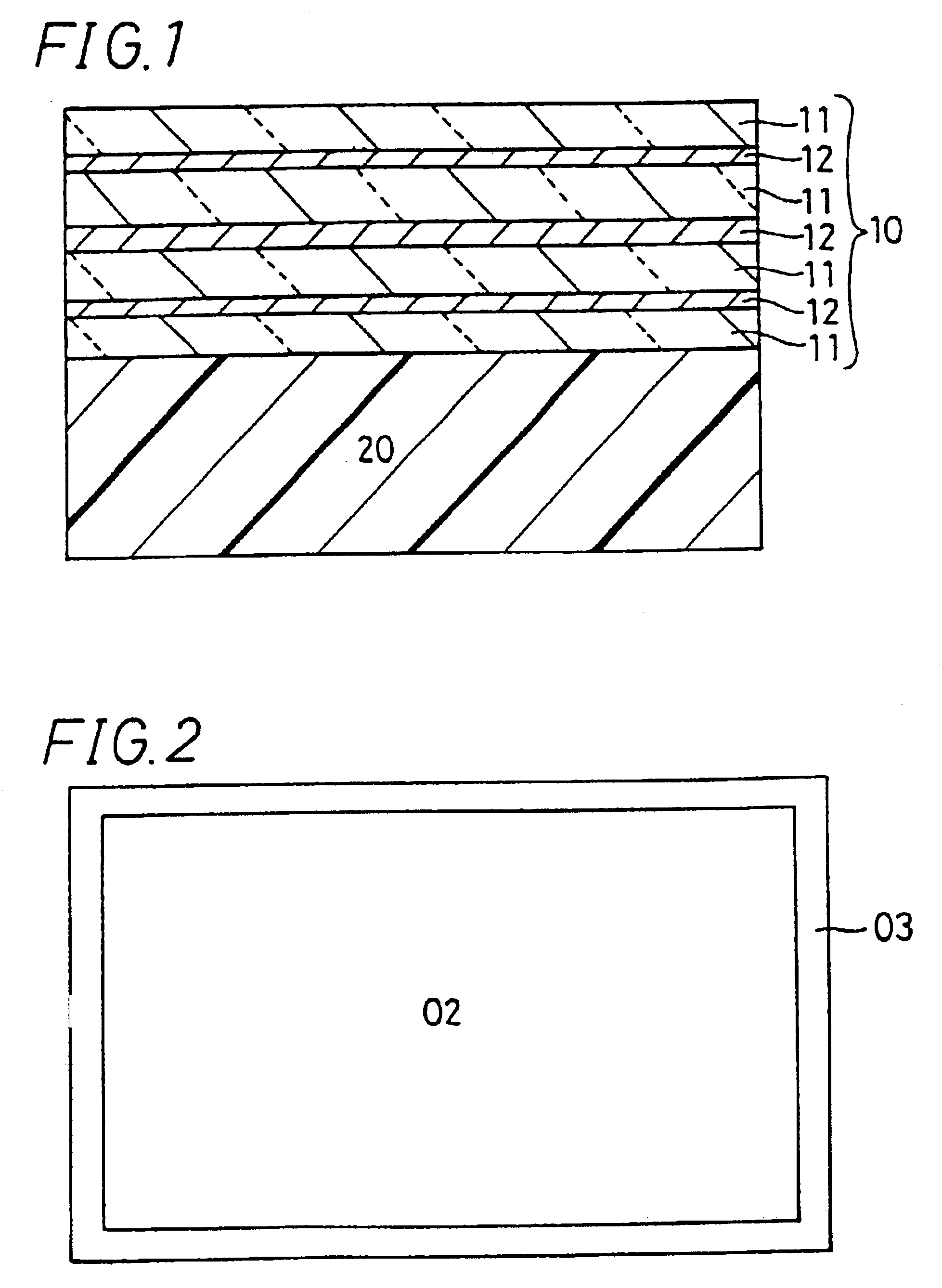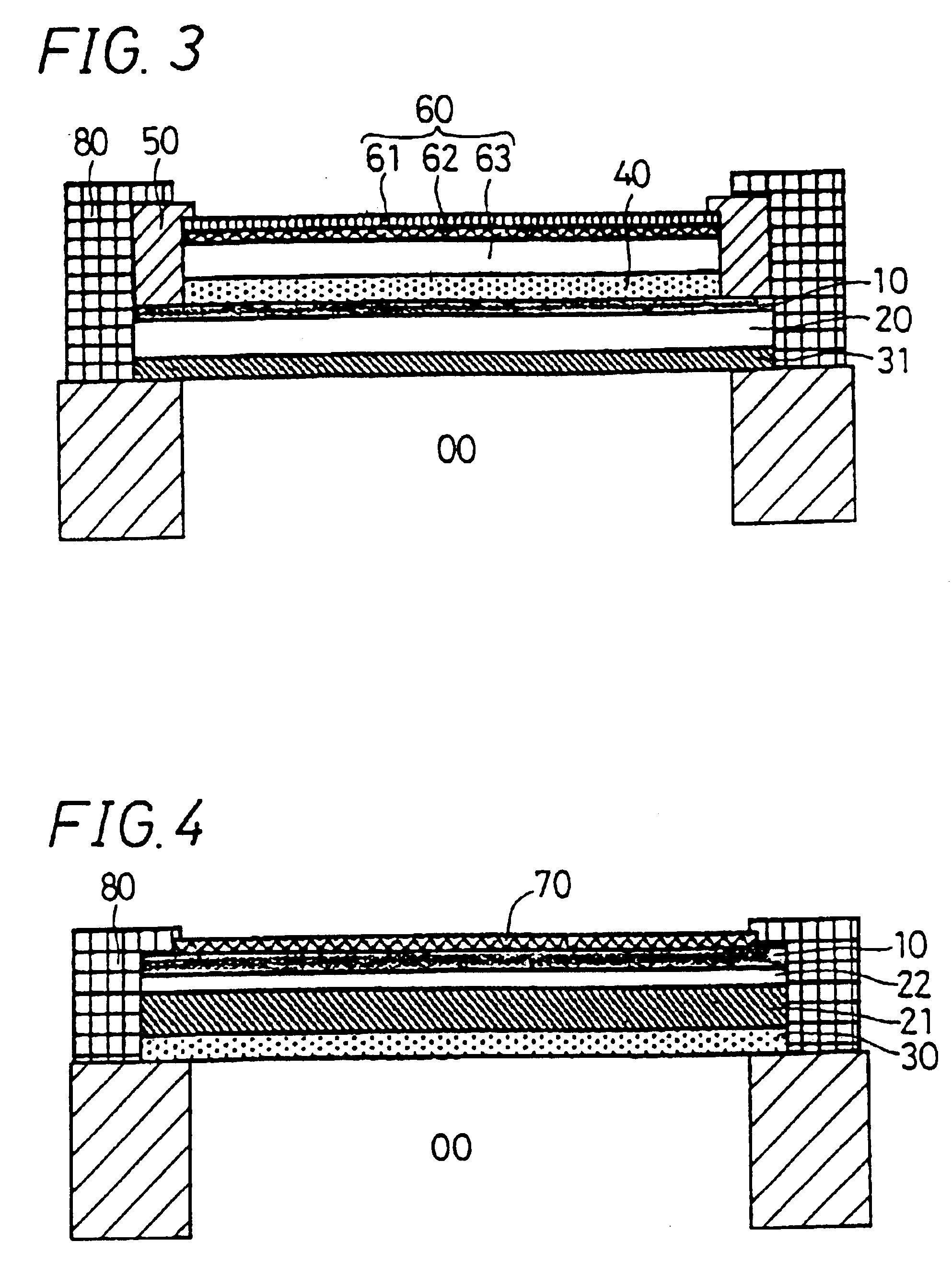Display filter, display apparatus, and method for production of the same
a technology of display apparatus and filter, which is applied in the manufacture of electrode systems, electric discharge tubes/lamps, instruments, etc., can solve the problems of reducing the cutting-off capacity of near-infrared rays, affecting the image affecting the appearance quality of the display apparatus, etc., to achieve excellent image/visibility/cost, excellent electromagnetic wave shielding capacity, and light weight
- Summary
- Abstract
- Description
- Claims
- Application Information
AI Technical Summary
Benefits of technology
Problems solved by technology
Method used
Image
Examples
example 1
[0332]Designating a biaxially stretched polyethylene terephthalate (hereinafter referred to also as PET) film (188 μm thick) as a polymer film (A), a transparent electrically conductive layer (B) comprising 7 layers in total made up of an ITO thin film (40 nm thick), a silver thin film (11 nm thick), an ITO thin film (95 nm thick), a silver thin film (14 nm thick), an ITO thin film (90 nm thick), a silver thin film (12 nm thick) and an ITO thin film (40 nm thick) in this order as viewed from a side of the PET film was formed on one major surface of the PET film to prepare a transparent laminate 1 comprising the transparent electrically conductive layer (B) having a surface resistance of 2.2 Ω / square.
[0333]A cross-section of a PET film / a transparent electrically conductive layer is shown in FIG. 1 as an example of a polymer film (B) / a transparent electrically conductive layer (D) according to the invention. A reference numeral 10 in FIG. 1 denotes a transparent electrically conductiv...
example 2
[0340]Polyethylene terephthalate pellets 1203 (manufactured by Unitika, Ltd.) were mixed with 0.01% by weight of a red color dye PS-Red-G manufactured by Mitsui Chemicals, Inc. for correcting chromaticity of white color luminescence and 0.015% by weight of a violet color dye PS-Violet-RC manufactured by Mitsui Chemicals, Inc., melted at a temperature of from 260° C. to 280° C. and extruded to form a film having a thickness of 200 μm. Thereafter, this film was biaxially stretched to prepare a PET film (polymer film (B)) containing a dye and having a thickness of 100 μm.
[0341]On one major surface of the PET film, a coating liquid in which alkoxysilane was decomposed by glacial acetic acid and added with a silicone type surface smoothing agent was applied by a gravure coater, and then thermally cured at 120° C. to form a hard coat film (film thickness: 10 μm, pencil hardness: 3H) thereby obtaining a PET film containing a dye in which a hard coat layer (F) is formed. On the hard coat la...
example 3
[0347]In the same manner as in Example 1, a laminate comprising a polymer film (B) / a transparent electrically conductive layer (D) was prepared.
[0348]Further, on a major surface of the PET film / transparent electrically conductive layer wound in roll form, opposite to a PET film thereof, a next functional transparent layer 1 was continuously formed as a functional transparent layer (A) by a roll-to-roll method. Namely, a coating liquid in which a photopolymerization initiator was added to a multi-functional methacrylate resin and, further, ITO fine particles (average particle diameter: 10 nm) were added thereto was applied by a gravure coater and, then, cured by an ultraviolet ray to form an electrically conductive hard coat film (film thickness: 3 μm) and, then, a fluorine-containing organic compound solution was coated on the thus-formed hard coat film by a micro gravure coater and dry-cured at 90° C. to form an anti-reflection film (film thickness: 100 nm) having a refractive inde...
PUM
| Property | Measurement | Unit |
|---|---|---|
| wavelength range | aaaaa | aaaaa |
| transparent | aaaaa | aaaaa |
| visible light ray transmittance | aaaaa | aaaaa |
Abstract
Description
Claims
Application Information
 Login to View More
Login to View More - R&D
- Intellectual Property
- Life Sciences
- Materials
- Tech Scout
- Unparalleled Data Quality
- Higher Quality Content
- 60% Fewer Hallucinations
Browse by: Latest US Patents, China's latest patents, Technical Efficacy Thesaurus, Application Domain, Technology Topic, Popular Technical Reports.
© 2025 PatSnap. All rights reserved.Legal|Privacy policy|Modern Slavery Act Transparency Statement|Sitemap|About US| Contact US: help@patsnap.com



